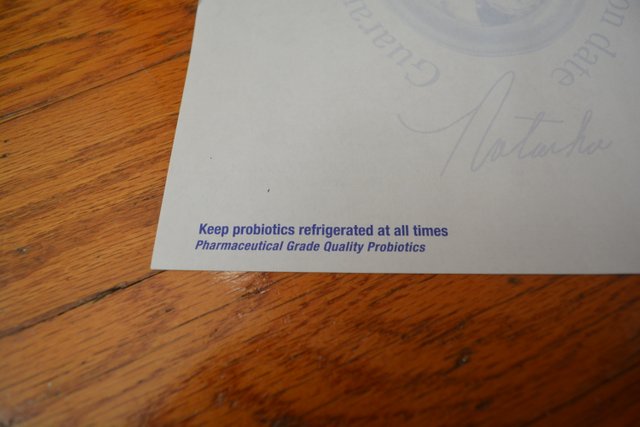Pharmaceutical, Probiotic Supplement Supply Chain Management - IoT and NEM Use Case
Hello all, Bader here (ツ)
As you know, the last article I wrote was about how we could use IoT and NEM to track meat from the moment it was slaughtered to the supermarket. I will be using much of the same principes in this example, so be sure to check it out if you haven't already.
So, this probiotic supplement just came to my door from Amazon. No, not a drink like Yalkult or Kombucha, a
pharmaceutical grade product.
Probiotics are living, breathing organisms. They need certain conditions to survive and not activate too early within the bottle.
This led me to ask: How do I know that this living product is alive? How do I know I'm getting my money's worth?
As this came directly from the manufacturer, this is the first time I've seen one of these arrive packed with an actual cooling agent. Usually, they arrive in a toasty warm bubble mailer straight from the Amazon FBA, basically the worst possible conditions for this type of pharmaceutical.
Why should you care?
The entire supplement market was worth over $100 billion in 2017. Probiotic supplements are a niche in this market, but they are growing in popularity. They are projected to hit a market of $7 billion by 2025. Overall, the entire market is growing and has upwards trend. . There are many people with gastrointestinal issues that need an excess of probiotics to help rebuild their gut. In fact, there is much research that suggests that many of the diseases stems from your gut/GI tract, and is very often overlooked by medical professionals. I know this from personal experience.
The problem
A little background about these supplements: They contain probiotics, live bacteria that is amazing for your gut. As with anything alive, they can only handle so much heat before they activate and die. In the case with probiotics, it only takes some heat or humidity for them to activate. As the environment in the bottle is not suitable for the bacteria, they die out fairly quickly. Considering each small bottle can cost $30-$40, you do not want that happening.
This leads me to believe the problem is not with the manufacturer, but rather with the transition from distributor to consumer and the conditions in which it was stored.
A real-world example
Recently, however, the company Natren themselves have started a Amazon storefront. This was the box a supplement was shipped in:
This was just for ONE bottle, and this is pretty big box. This cost around $26 USD, and this is at a discount because they are just opening their Amazon store.
Originally this cost around $42 with shipping from their actual website. They pack it with "Dry Ice" (spoiler: it's just a gel refrigerant, still great though). Interestingly enough, it says on their invoice that they have to be refrigerated at all times. As said before, this is to keep the bacteria alive.
Keep probiotics refrigerated at all times
Pharmaceutical Grade Quality Probiotics
Inside the box
In order to truly see if it was shipped under the right conditions (at least as much as I could see), I measured the temperature within the box and the actual supplement itself:  )
)
I took multiple readings, and the average temperature was 69°F, not bad, but not too great either. This means that there was perhaps some loss of organisms within the bottle, but the loss wasn't too great. The real question, however, is how long have these been sitting in a warehouse or truck until I have received them?
For all I know, the box of bottles could've been sitting in a hot warehouse and not stored properly until later (though if the manufacturer took the trouble to cool the shipment, it is more likely a company like Amazon did wouldn't have stored them properly).
A solution - using NEM & IoT
Using the same technology from the previous article, we can use a SparkFun Thing and DHT11 temperature/humidity sensor combo to monitor the temperature of the bottle.
This module communicates directly with the NEM blockchain. There are no servers in between.
Of course, it doesn't make sense to put a tracker in every box shipped to your door, but it is possible to have one passively taking readings whilst in storage. That way when you receive it in the mail, you can scan it and check if that batch was stored in the proper conditions, thus knowing if you got your money's worth!
Conclusion
The point of these articles is to outline problems in various industries. There are many applications for this type of variable tracker, not all of which involved temperature. Using this technology, we can provide a surefire way to measure any parameter of our choosing and upload it securely to a blockchain, where it is immutably stored.
I am going to call this whole operation this the CryptoConfirm Project.
And I also have a website now! If you think anything should be added to it, let me know: cryptoconfirm.io.
As always, if you want to talk more IoT, blockchain, or anything tech feel free to contact me on Telegram @crackingcode.
If you thought I missed anything, please feel free to correct me.
Thank you for reading!


Good article brother..
Well doing...
Congratulations @crackthecode! You have completed the following achievement on Steemit and have been rewarded with new badge(s) :
Click on the badge to view your Board of Honor.
If you no longer want to receive notifications, reply to this comment with the word
STOPTo support your work, I also upvoted your post!
Do not miss the last post from @steemitboard:
SteemitBoard World Cup Contest - Final results coming soon
@crackthecode, you are interesting to read!